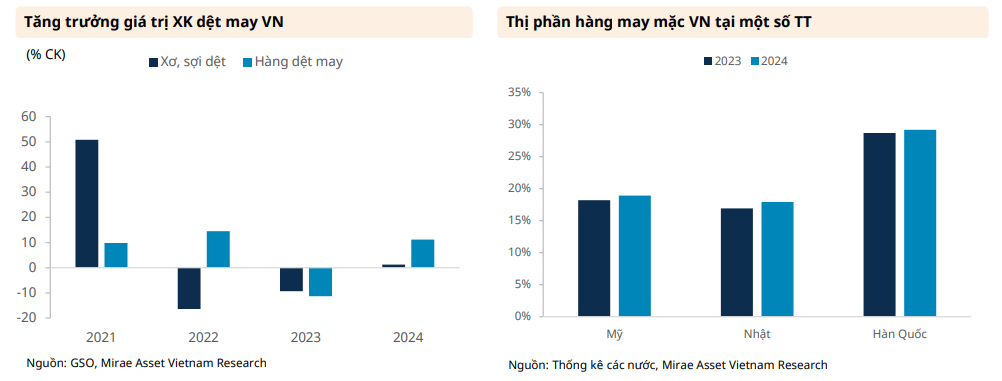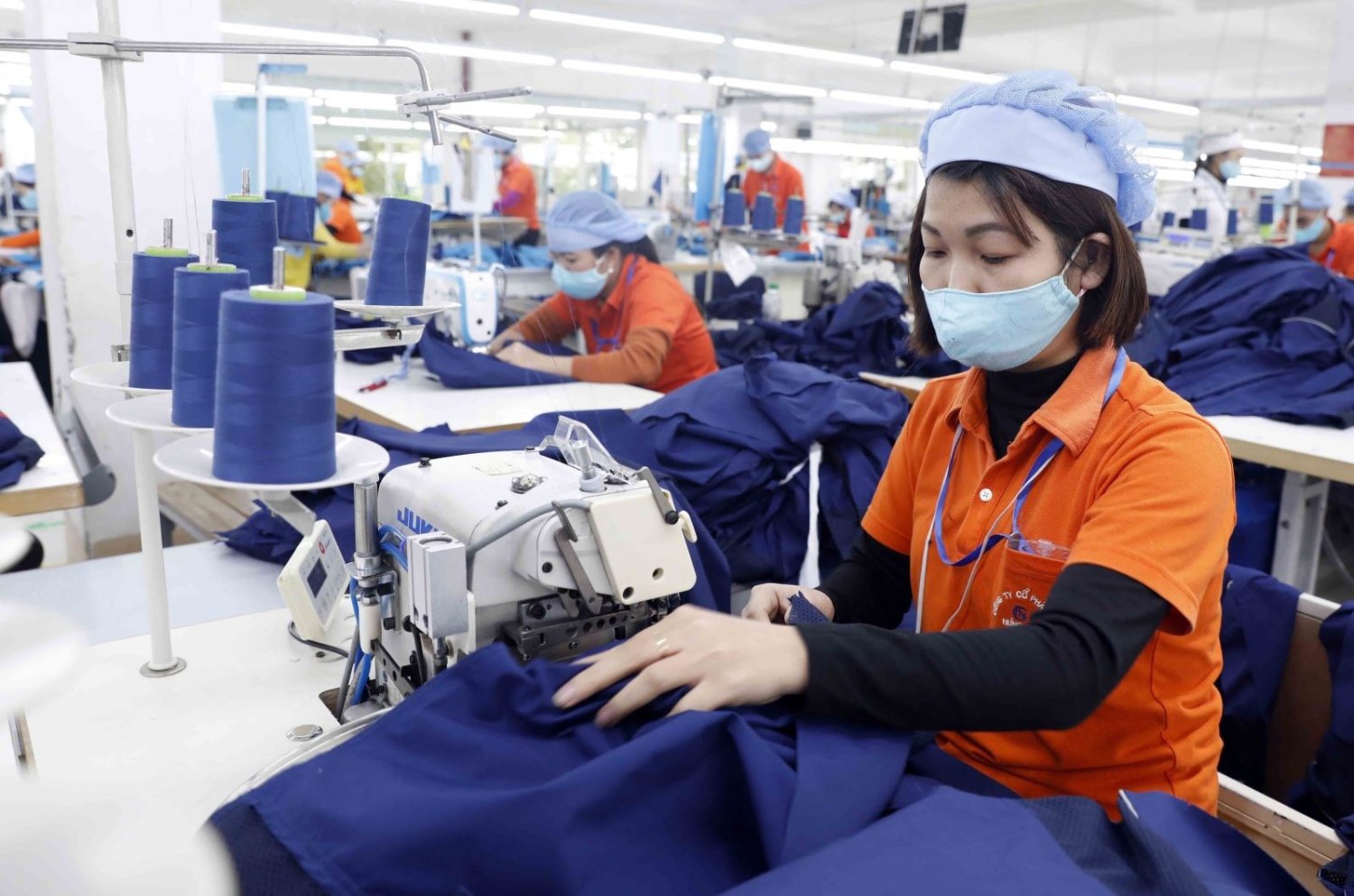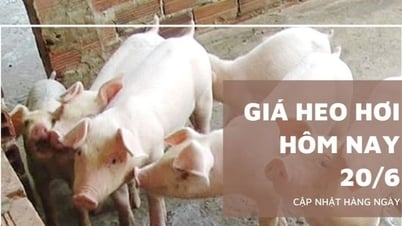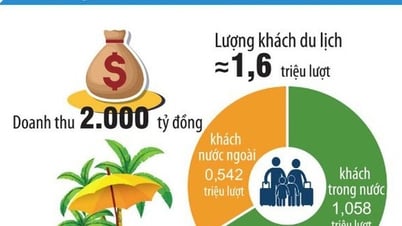According to Mirae Asset, although Vietnam's textile and garment industry has seen significant growth in 2024, new challenges are emerging, mainly from macroeconomic uncertainties.
Growth in both key segments
According to a recent industry report by Mirae Asset, Vietnam’s textile and garment industry will record positive export growth in 2024, with export value increasing in both yarn and textile products. However, the growth rate is uneven between the two segments, in which textile products still maintain high growth momentum, while yarn growth is only modest. In 2024, yarn and textile product exports are estimated to reach 4.4 billion USD (up 1.2% YoY) and 37 billion USD (up 11.2% YoY).

By the end of 2024, Vietnam's apparel market share in major markets continues to expand, including the United States (18.9%; 2023: 18.2%), Japan (17.9%; 2023: 16.9%) and South Korea (29.2%; 2023: 28.7%). Notably, although the market share in South Korea decreased slightly for most of the year, it recorded growth by the end of 2024. In addition, Vietnam's apparel market share in the United States and Japan continued to expand throughout the year. Meanwhile, competitors such as China and Bangladesh generally saw a decline in market share.
By the end of 2024, China will remain the largest market for Vietnamese yarn, accounting for 47.7% of total export turnover. Textile production volume in China continues to increase and garment production volume also grows again.
Domestic textile and garment production continues to improve in 2024, especially in the fourth quarter of 2024. In 2024, the IIP of the textile and garment sectors will increase by 11.7% and 12.1% respectively compared to 2023. In addition, the employment index of textile and garment workers will continue to grow.
Cotton prices remain low at around $68/lb in late 2024 and early 2025, the lowest since October 2020. This could signal a decline in input demand in the textile value chain.
Prospects and risks in 2025
According to the latest forecasts from the World Bank, real GDP growth in 2025 is forecast to continue for Vietnam’s key markets, including the United States (+2.3%); the EU (+1%); Japan (+1.2%); and China (+4.5%). Economic growth will sustain demand for textile and apparel products in these markets.
The development to watch is the US tariff war. Immediately after the US President took office, the US government announced many new tariff measures against Canada, Mexico and China, as well as plans to apply new "reciprocal tariffs" against many other countries. However, since the Trump administration has left the door open for negotiations and there is still time before the new tariffs are applied (within 180 days for calculation and planning), Mirae Asset believes that there is still an opportunity for Vietnamese textile products to avoid high tariffs.

In addition, monetary policy developments are mixed in key markets. In 2024 and early 2025, some Western central banks began to lower their policy rates. However, in the context of recent rising inflation, the Fed has slowed down the pace of policy rate cuts to a maximum of 0.5 percentage points in 2025. This will put pressure on other central banks to continue cutting interest rates. High interest rates will negatively affect consumer demand. In addition, the Fed's slowing down of interest rate cuts will likely put pressure on currencies in Asian markets, such as the Japanese Yen and the Korean Won, which will reduce purchasing power in these markets.
In terms of inventory and sales for major brands, the inventory-to-sales ratio for major brands — such as Nike, Inditex, GAP, H&M, and Puma — has shown signs of increasing by the end of 2024, partly due to efforts to build up inventory levels before Trump took office. More specifically, overall inventory figures have stopped falling, while some brands have seen inventory increase. Meanwhile, revenue continues to grow solidly thanks to year-end demand.
Overall, consumer confidence in major markets weakens in late 2024 and early 2025. Indexes in most major markets decline from November 2024. Notably, the US confidence index recorded a significant decline in February 2025 to below 70. Mirae Asset believes that the possibility of higher inflation and the Fed's slower pace of rate cuts are the main reasons for the decline in consumer confidence.
Commenting on short-term risks, Mirae Asset said that macro uncertainties, such as geopolitical issues and the US government's tariff policies, will be the main risks to textile demand in 2025. Despite recent developments in negotiations surrounding the Ukraine-Russia and Israel-Hamas wars, tensions between countries remain high, posing major risks to the economy.
In the long term, with increasing FDI inflows into Vietnam, textile and garment companies may face pressure from rising labor costs. In addition, Vietnamese workers can now more easily seek jobs abroad, increasing wage competition at home.
Source: https://baodaknong.vn/nganh-det-may-truoc-kho-khan-va-co-hoi-dan-xen-243376.html







![[Photo] General Secretary To Lam chairs the 14th Central Military Commission Conference](https://vphoto.vietnam.vn/thumb/1200x675/vietnam/resource/IMAGE/2025/6/20/a9d25fc6dd664fb9a3757502f32e5db0)













![[Maritime News] Wan Hai Lines invests $150 million to buy 48,000 containers](https://vphoto.vietnam.vn/thumb/402x226/vietnam/resource/IMAGE/2025/6/20/c945a62aff624b4bb5c25e67e9bcc1cb)









































































Comment (0)